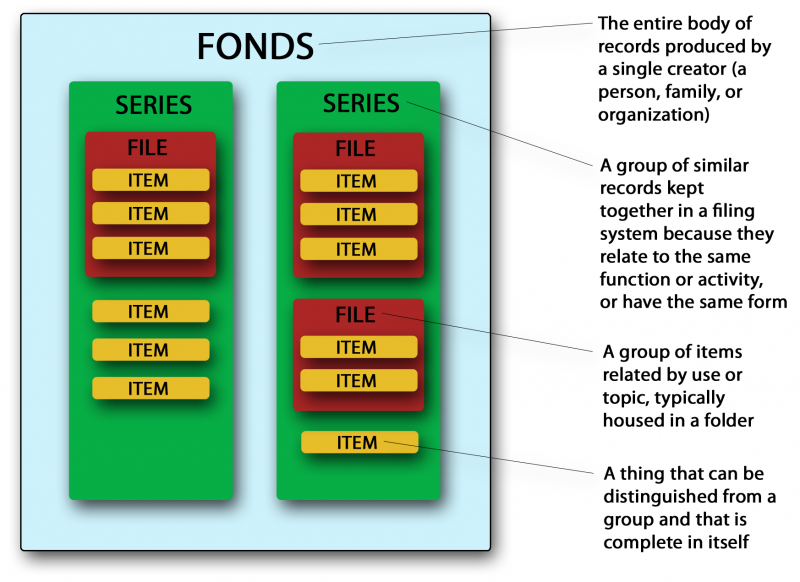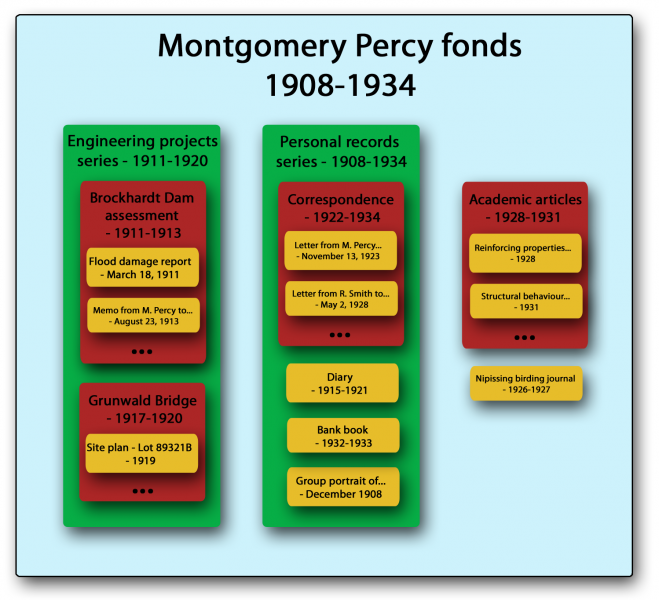This guide provides a basic introduction to how the records in archives are arranged and described, which will help you search and understand them better.
What are records?
Records are any information or data in a fixed form that were created in the ordinary course of business and preserved for future reference. Common types of records include: textual records (such as correspondence, minutes, reports, and budgets), photographs, maps, architectural drawings, audio recordings, and video recordings. Records are unpublished, unlike books and other publications, and can be analog or digital.
How are records arranged?
In archives, records are arranged (organized) according to their creator, which is the individual, family, or organization that created or received the records. The entire body of records of a single creator is known as a fonds. For example, all the records created or received by the Acme Steamship Corporation would be kept together in a group known as the "Acme Steamship Corporation fonds." Each fonds is kept strictly separate from other fonds, so that the records of one creator are never mixed with those of another creator.
Records are always kept in their original order, which is the organization and sequence they were put into by their creator. The original order is important because it provides significant evidence about how the creator created, used, and reviewed the records. For example, the original order of undated letters in a file might indicate the chronological order in which they were received, or provide other clues as to how their creator used them. Because this contextual information can be lost forever if the original order is disrupted, records are never physically rearranged.
What is archival description?
Through the process of archival description, archivists analyze records and create descriptions (also called finding aids) which provide information about the records, including: title, creator, dates of creation, extent (physical quantity), and contents. Archivists describe records in order to make them searchable and more fully understandable by researchers.
While paper finding aids used to be the norm, descriptions are now usually digital and are often housed in databases. Databases provide many advantages over paper finding aids, including: online access, full-text searching, filters to narrow search results, and the ability to include digital objects such as scans of photographs and documents. The Archives has a searchable online descriptive database where you can learn more about its archival holdings.
How are descriptions structured?
Archival description in Canada follows the Rules for Archival Description, a national standard that dictates which information elements are required for descriptions and how they must be structured. This standard ensures that descriptions from archives across Canada have the same general structure and the same types of information, making it easier to share and understand them.
Unlike a library catalogue, where books and other publications are described individually, archival descriptions have a complex hierarchical structure of multiple interrelated levels that reflect the arrangement of the records. Each fonds can consist of multiple lower levels, including series, files, and items:

Please note that the structure is purely intellectual, and does not necessarily reflect the physical arrangement of records in files and boxes. From the diagram above you can see that the higher levels of description (like fonds and series) are made up of lower levels (like files and items). Each higher level of description thus summarizes the lower levels which it contains. For example, a file containing individual letters (items) dated 1913, 1914, and 1916 might have a summarizing title like "Correspondence" and the date range 1913-1916. Each level may contain any number of lower levels, and it may not include any.
Here's an example of how the structure of an actual fonds might look:

The title of fonds are always based on the name of the fonds™ creator, that is, the person, family, or organization that created the records. The titles of series, files, and items are the titles given to them by their creator, although sometimes with extra information or explanations of acronyms provided in square brackets by the archivist (for example, a file title like "ONR - Plans" might be expanded to "O[ntario] N[orthland] R[ailway]" “[Site] plans" to make its contents more understandable). If the creator did not provide a title for a series, file, or item, the archivist will create one that provides a succinct summary of its contents. If a title is supplied, the archivist will explain this in a "Source of title proper note" attached to the description.
What do I do when I have located records relevant to my research?
Make a note of the reference codes and titles of the files and items that you would like to access, so that they can be retrieved. Do not include the first 9 digits (CA ON00408) of the reference code, as this is the Archives™ institution code. When ready, contact the Manager of Archives and Special Collections to set up an appointment and bring the list with you when you visit the Archives.
